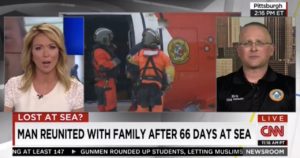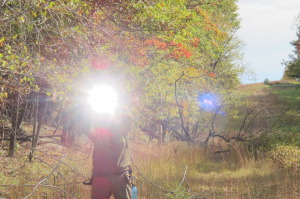Rescue Signaling: Tips to Consider
Whether we choose to hike, hunt, paddle, or take part in any other number of outdoor activities where we can enjoy the harmony of nature, either alone or with friends, emergencies can occur. While medical problems can be one possible reason, one of the most common is simply getting lost. Regardless of the specific reason, it can be a huge boost of relief, after first instinctively reaching for your mobile telephone and dialing 9-1-1, to hear, “County 911, what is your emergency?” on the other end. However, it can be absolutely crushing to discover that you have no signal at all, or just as badly, having your telephone battery die half-way through the call. Unfortunately, both happen all too often in the outdoors.
So here are few important safety tips for you to consider …
1. Being Found is Mostly Your Responsibility
You should be prepared at all times to “reach out and touch someone” when the need arises. After all, in any emergency situation, Signaling is one of your seven survival priorities.
There are a few factors to keep in mind. One should carry appropriate signaling equipment for the expected activity, conditions, and terrain. For example, what I carry with me while kayaking on the ocean differs from what I carry while hiking in the woods. Also, learn to know when, where, and how, to use your signaling device before an emergency occurs.
It is also important to keep in mind that despite common belief, rescuers won’t likely be relying on helicopters equipped with hi-tech detection gear to locate you, but even if they do, you would still likely remain the proverbial needle in the haystack. During one high profile incident off the coast of Florida three years ago, the Coast Guard conducted a massive search that covered the equivalent land mass of Pennsylvania and West Virginia combined looking for two people on the ocean surface. So if you consider yourself in such a situation, you’ll better understand that having and using the right signaling device can immensely improve your odds of rescue.
The simple reality, then, as we teach our clients in our survival programs at True North, is that being found is your responsibility, not rescuers. It is a proactive process that doesn’t rely solely on luck.
2. Don’t Rely Too Much on Your Telephone
Without a doubt, mobile telephones are an important signaling device. After all, there are few devices that offer us in an emergency the ability to talk with someone instantaneously in real time. This is certainly helpful and comforting, to put it mildly.
However, I am a bit conflicted about mobile telephones. To begin, too many of us place too much confidence in these devices such that we assume risks that we might otherwise avoid (getting us into trouble in the first place). Secondly, many are too reliant on them to the absolute exclusion of other signaling equipment — Okay, you are speaking with a dispatcher, but can you tell her where you are amongst all of the trees? And lastly, many fail to grasp how quickly their batteries deplete in remote locales, especially so-called “smart phones.” Trust me, there are repeated news accounts of lost hikers who started to talk with the 911 dispatcher only to have their call terminate mid-conversation.
To save your battery, remember to fully charge your telephone prior to your adventure, then turn it off (or, at least, put it in “airplane mode”) just as you set out, only turning it on when you actually need it. This way, you’ll have a full battery in case of an emergency. After all, if you ever need to dial 9-1-1, you’ll likely be making, and receiving, multiple ongoing calls throughout the rescue.
3. At a Minimum, Always Carry a Whistle
One of the most fundamental, and best, signaling devices is the whistle. Granted, it isn’t exactly impressive, but it can be worth it’s weight in gold should you need to get someone’s attention. Yes, I know, you can shout; and, yes, you can whistle quite impressively with your fingers in your mouth. But you shouldn’t be so confident: you can only yell so long and so hard until your voice gives out (which isn’t long at all); sound is also quickly absorbed by surrounding vegetation, snow, rain, and wind; your voice and lip whistle doesn’t have the same high decibel level as a real whistle; and, besides, heck, how well can you whistle if you are hypothermic, or your arm is broken?
So just buy a good whistle, preferably without the ball (as the ball may freeze in winter due to your excess spittle) and keep it in your pocket. I am not a fan of “buckle whistles,” which are now common on backpack shoulder straps, since they are not as loud as standard whistles; are practicably inaccessible if you are wearing your pack; and no good if you are separated from it.
4. Signal in Threes
If you need to signal for help, remember that “3” is the international number of distress. That is, three of anything in rapid succession like three gun blasts, three whistle blasts, or three fires in a row or triangle, means that you need help.
5. Contrast is King
Visual cues are an important way to be found so be prepared to stand out from your surroundings. You can do this in any number of ways. For example, pack a blaze orange tee-shirt that you can either wear or swing over your head to attract attention. Consider, too, putting a signal mirror in your pocket: even on partly cloudy days one can signal rescuers on land, sea, or in the air from tremendous distances.
Fire craft is an important skill to learn, whether for signaling or a multitude of other purposes. As we teach our clients, you should always be prepared to start a fire, in five minutes, in the pouring rain. Yes, trust me, it can be done.
6. Read the Instructions Before the Emergency
In the end, no matter what type of signaling device you decide to use be sure that you know how to use it before you actually need it. This may sound obvious, but you might be surprised just how many believe that they can simply read the instructions when the need arises. However, the reality is that, due to millions of years of evolution, under stress our brains effectively shrink to the size of a pea such that we rarely can process such information. For example, the standard rescue mirror may have only three very simple instructions printed on its back, but under the stress of an emergency, it will feel like you are reading and trying to memorize an encyclopedia. The best way, then, to overcome this flight-or-fight reflex is to train and practice such skills like you mean it.
7. Consider Carrying a PLB
One of the most effective signaling devices that you can carry is a Personal Locator Beacon (PLB). This most especially if you plan on spending time on the ocean or in the woods. Not only does it effectively send a rescue signal, but it will identify your location.
At True North, we typically recommend those products manufactured by ACR Artex since that is what I carry during my own outdoor adventures.
Here is a video about one of their models that will also provide you a general overview of PLBs too:
8. Improvise If You Must
Sometimes Murphy’s Law affects even the best prepared so remember that improvisation and adaptability is the essence of survival. So, if you must, use what you have to the best of your ability and imagination.
For example, a few years ago a commercial fisherman, who had already been lost at sea for several weeks on his boat, was unable to attract the attention of a passing plane until in his desperation he grabbed a fire extinguisher, raised it above his head, and pressed the handle — causing a giant white CO2 cloud to contrast against the blue sea which caught the pilot’s attention. The pilot then radioed the Coast Guard who rescued the fisherman a few hours later.
Conclusion
No matter which signal device you pick, always remember that survival begins before the emergency.
——————
Would you like to learn more about signaling? Then consider registering for an upcoming Wilderness Survival 101 or Basic Wilderness Survival course.



